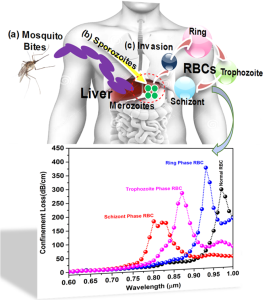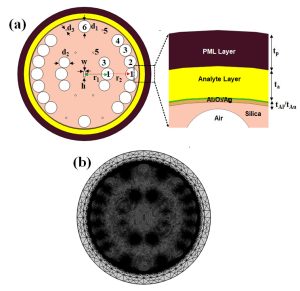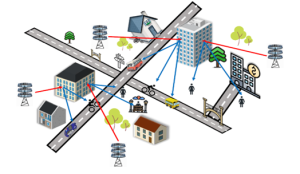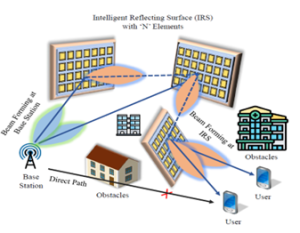A Breakthrough Patent for the Automated Abnormality Detection System
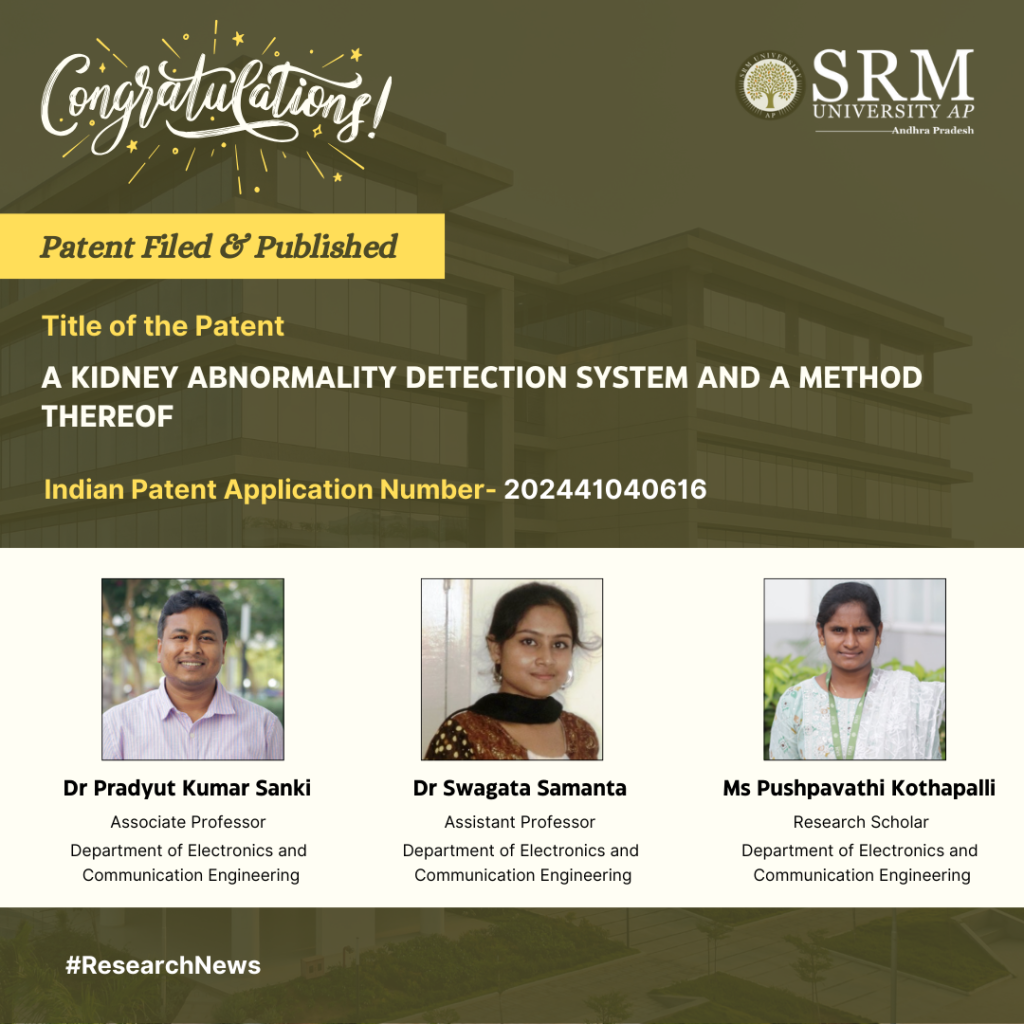
Dr Pradyut Kumar Sanki, Dr Swagata Samanta, and research scholar Ms Pushpavathi Kothapalli from the Department of Electronics and Communication Engineering published their patent titled “A Kidney Abnormality Detection System And a Method Thereof,” with Application No. 202441040616. This innovative method, which utilises advanced deep learning techniques, promises to revolutionise the accuracy and efficiency of kidney disease diagnosis. With the potential for widespread clinical adoption, this technology aims to enhance patient care, offering a brighter future for kidney disease detection and treatment.
Abstract:
This research work aimed to develop a method for detecting kidney diseases, including kidney stones, cysts, and tumors. The method achieved high accuracy in detecting kidney diseases, with a good mean average precision, precision, and recall. The study used techniques to select the most relevant features for kidney disease detection, identifying top features related to blood tests and patient health. The method outperformed other approaches in terms of accuracy, precision, and recall. The study used a comprehensive dataset of kidney disease patients to train and test the method. The results suggest that the method has the potential to be widely adopted in clinical settings, contributing to more accurate and efficient diagnostic tools for kidney disease detection and improving patient care.
Practical implementation:
The practical implementation of our research involves deploying a system for real-time detection and classification of kidney disease, including kidney stones, cysts, and tumors. The method achieved high accuracy in detecting kidney diseases using the Deep learning technique. Our model can quickly identify the disease of the kidney. The study used techniques to select the most relevant features for kidney disease detection, identifying top features related to blood tests and patient health. The method outperformed other approaches in terms of accuracy, precision, and recall. The study used a comprehensive dataset of kidney disease patients to train and test the method. The results suggest that the method has the potential to be widely adopted in clinical settings, contributing to more accurate and efficient diagnostic tools for kidney disease detection and improving patient care.
Future Research Plans:
The future plans for the work on chronic kidney disease (CKD) detection and management involve several key areas:
1. Improved Screening and Diagnosis: Update the United States Preventive Services Task Force (USPSTF) recommendation for CKD screening to reflect current evidence supporting routine screening for high-risk asymptomatic adults.
2. Enhanced Patient Engagement and Person-Centered Care: Advance education of primary care clinicians about CKD risk factors, testing, detection, and interventions that are graded and proportional to the eGFR and uACR risk stratification or heat map.
3. Advancements in Nephrology: Develop novel therapeutic strategies, such as wearable artificial kidneys, xenotransplantation, stem cell-derived therapies, and bioengineered and bio-artificial kidneys, to improve renal replacement therapies and address the shortage of kidney donors.
4. Machine Learning and Predictive Modelling: Continue to evaluate and improve machine learning approaches for early CKD diagnoses, focusing on reducing the number of input features and enhancing the accuracy of prediction models.
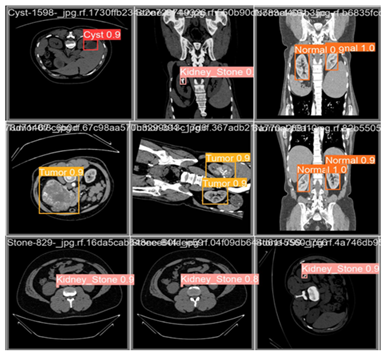
- Published in Departmental News, ECE NEWS, News, Research News
Groundbreaking Paper Offers Geo-Temporal Visualisation of COVID-19 Spread in India
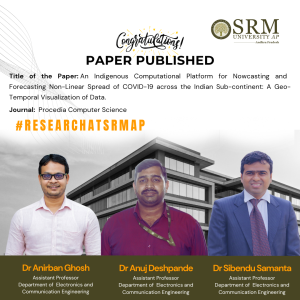 In an exciting development, Dr Anirban Ghosh, Dr Anuj Deshpande, and Dr Sibendu Samanta, Assistant Professors from the Department of Electronics and Communication Engineering, have recently achieved a significant milestone with the publication of their paper titled “An Indigenous Computational Platform for Nowcasting and Forecasting Non-Linear Spread of COVID-19 across the Indian Sub-continent: A Geo-Temporal Visualization of Data” in the esteemed journal, Procedia Computer Science.
In an exciting development, Dr Anirban Ghosh, Dr Anuj Deshpande, and Dr Sibendu Samanta, Assistant Professors from the Department of Electronics and Communication Engineering, have recently achieved a significant milestone with the publication of their paper titled “An Indigenous Computational Platform for Nowcasting and Forecasting Non-Linear Spread of COVID-19 across the Indian Sub-continent: A Geo-Temporal Visualization of Data” in the esteemed journal, Procedia Computer Science.
The paper focuses on the development of a state-of-the-art computational platform specifically tailored for nowcasting and forecasting the non-linear spread of COVID-19 across the Indian sub-continent. This pioneering work promises to offer valuable insights into the geo-temporal visualisation of data related to the COVID-19 pandemic, with potential implications for public health interventions and policy decisions.
The publication of this paper serves as a testament to the innovative research being conducted by the faculty members at the Department of Electronics and Communication Engineering. Their dedication and expertise in the field have not only contributed to advancing scientific knowledge but also hold considerable promise for making a real-world impact in the ongoing fight against the COVID-19 pandemic. We extend our congratulations to Dr Anirban Ghosh, Dr Anuj Deshpande, and Dr Sibendu Samanta for this remarkable accomplishment and look forward to witnessing the continued impact of their research in addressing critical challenges facing the world today.
Abstract
The rapid spread of the COVID-19 pandemic necessitated unprecedented collective action against coronavirus disease. In this light,we are proposing a novel online platform for the visualisation of epidemiological data incorporating social determinants for understanding the patterns associated with the spread of COVID- 19. The current AI computational platform combines modelling methodologies along with temporal, geospatial visualisation of COVID-19 data, providing real-time sharing of graphic analytical simulation of vulnerable hotspots of recurrent (nowcasting) and emergent (forecasting) infections visualised on a spatiotemporal scale on geoportals. The proposed study will be a secondary data analysis of primary data accessed from the national portal (Indian Council of Medical Research (ICMR)) incorporating 766 districts in India. Epidemiological data related to spatiotemporal visualisation of the demographic spread of COVID-19 will be displayed using a compartmental socio-epidemiological model, reproduction number R, epi-curve diagrams, as well as choropleth maps for different levels of administrative and development units at the district levels.
Explanation of the Research in Layperson’s Terms
The rapid spread of COVID-19 required quick and coordinated action. To aid the process, we have created a new online platform to help visualise COVID-19 data, including social factors that affect its spread. Our platform uses advanced computer models and shows COVID-19 data over time and across locations. It allows real-time sharing of visual analyses, highlighting areas at risk for current and future infections. The effectiveness of the platform lies in the fact that it is not limited to COVID-19. It can be suitably modified and employed for capturing similar trends for any future pandemic.
Title of the Research in the Citation Format
Priya Ranjan, Dhruva Nandi, Karuna Nidhi Kaur, Rohan Rajiv, Kumar Dron Shrivastav, Anirban Ghosh, Anuj Deshpande, Sibendu Samanta, Rajiv Janardhanan, “An Indigenous Computational Platform for Nowcasting and Forecasting Non-Linear Spread of COVID-19 across the Indian Sub-continent: A Geo-Temporal Visualization of Data”, Procedia Computer Science, Volume 235, 2024, Pages 496-505, ISSN 1877-0509,
https://doi.org/10.1016/j.procs.2024.04.049
Practical Implementation and Social Implications Associated
As mentioned earlier, the platform can be used to present real-time data analysis and identify emerging and current hotspots of the COVID-19 pandemic. However, the beauty or robustness of the platform lies in the fact that it can be suitably adapted for similar analysis for any future pandemic with minimum effort.
Collaborations
- University of Petroleum and Energy Studies, Energy Acres, Dehradun, Uttarakhand, India
- SRM Medical College Hospital and Research Centre, SRMIST, Kattankulathur, Tamil Nadu, 603203, India
- Amity Institute of Public Health, Amity University, Noida, Uttar Pradesh, 201303, India
Future Research Plans
The future plan includes improving the visual and graphical presentation of the platform to provide more insightful and intuitive information. Aggregation of data from other international databases would further augment the effectiveness of the platform by not limiting it to only the national scenario.
- Published in Departmental News, ECE NEWS, News, Research News
Innovative Aquaculture Monitoring System Patented by Dr K A Sunitha and Team
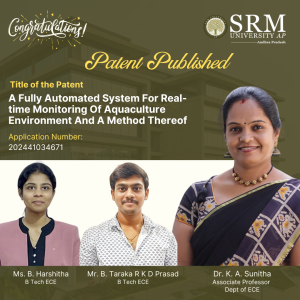 In a significant advancement for aquaculture technology, Dr K A Sunitha, Associate Professor in the Department of Electronics and Communication Engineering, along with her B.Tech ECE students Ms B Harshitha and Mr B Taraka Rameswara Kanaka Durga Prasad, have made headlines with their latest invention. The team has successfully filed and published a patent for “A Fully Automated System for Real-Time Monitoring of Aquaculture Environment and a Method Thereof.” The application number 202441034671, has been officially recorded in the Patent Office Journal, marking a milestone for the team and the institution they represent.
In a significant advancement for aquaculture technology, Dr K A Sunitha, Associate Professor in the Department of Electronics and Communication Engineering, along with her B.Tech ECE students Ms B Harshitha and Mr B Taraka Rameswara Kanaka Durga Prasad, have made headlines with their latest invention. The team has successfully filed and published a patent for “A Fully Automated System for Real-Time Monitoring of Aquaculture Environment and a Method Thereof.” The application number 202441034671, has been officially recorded in the Patent Office Journal, marking a milestone for the team and the institution they represent.
This pioneering system promises to revolutionise the way aquaculture environments are monitored by leveraging automation to ensure real-time, accurate assessments. The invention stands as a testament to the innovative spirit and dedication of Dr Sunitha and her students, who are now recognised as contributors to the technological advancements in the field of aquaculture.
Abstract
This project involves the design and development of an Automated water quality analysis system to assist aquaculture farmers. The proposed system is tailored for aquatic environments, particularly ponds to monitor crucial parameters say Dissolved Oxygen (DO), PH, Temperature and Humidity levels, signaling when concentrations drop below the predefined threshold set by the user every thirty minutes. The system features autonomous activation and deactivation of aerators to ensure continual oxygenation of water and aids in energy optimisation. Utilising advanced sensors and a microcontroller, the device offers continuous monitoring of parameters to facilitate pond operators with timely insights into water quality dynamics, enabling proactive interventions to protect aquatic ecosystems.
Brief Explanation of the Project
India is the second-largest aquaculture nation in the world, and this sector provides livelihood support to about 280 lakh people. The aquaculture industry globally faces numerous challenges, such as Viral, bacterial, and fungal diseases and Suboptimal water quality. One crucial criterion for evaluating the quality of water is measuring the Dissolved Oxygen level. Water and other liquids contain free, non-compound oxygen, which is measured as dissolved oxygen (DO).
Long-term exposure to low DO levels increases stress and infections and, in certain situations, causes the death of the organism because dissolved oxygen is essential for the health and reproduction of many fish and invertebrates. This project highlights the design of a timer based automated water quality analysis system which can be used in the inland aquaculture farms to continuously monitor the water parameters and automate the calibration process and the operation of aerators without human intervention.
Practical Implications of the Research
The main objectives of this research are
1) To monitor the parameters, say Dissolved Oxygen, PH, Temperature and Humidity levels
every thirty minutes.
2) To automate the Calibration process to maintain accuracy and reliability of the system.
3) To automatically turn ON/OFF the aerators in the event of Low/High oxygen levels detection in the pond.
4) To send notifications to the technician or farmer every thirty minutes to help them monitor.
Future Research Plans
The developed prototype is currently validated with standard DO meter during experimental trials. Moving forward, further research and development efforts may focus on refining the system’s functionality, expanding its sensor capabilities, and integrating advanced analytics for predictive monitoring and decision support, thereby advancing the state-of-the-art in aquaculture management technology and promoting the long-term viability of inland aquaculture operations.
Pictures Related to Research
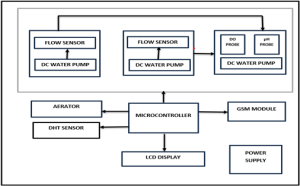
- Published in Departmental News, ECE NEWS, News, Research News
Developing Biosensors using Photonic Crystal Fibres and Surface Plasmon Resonance (SPR)
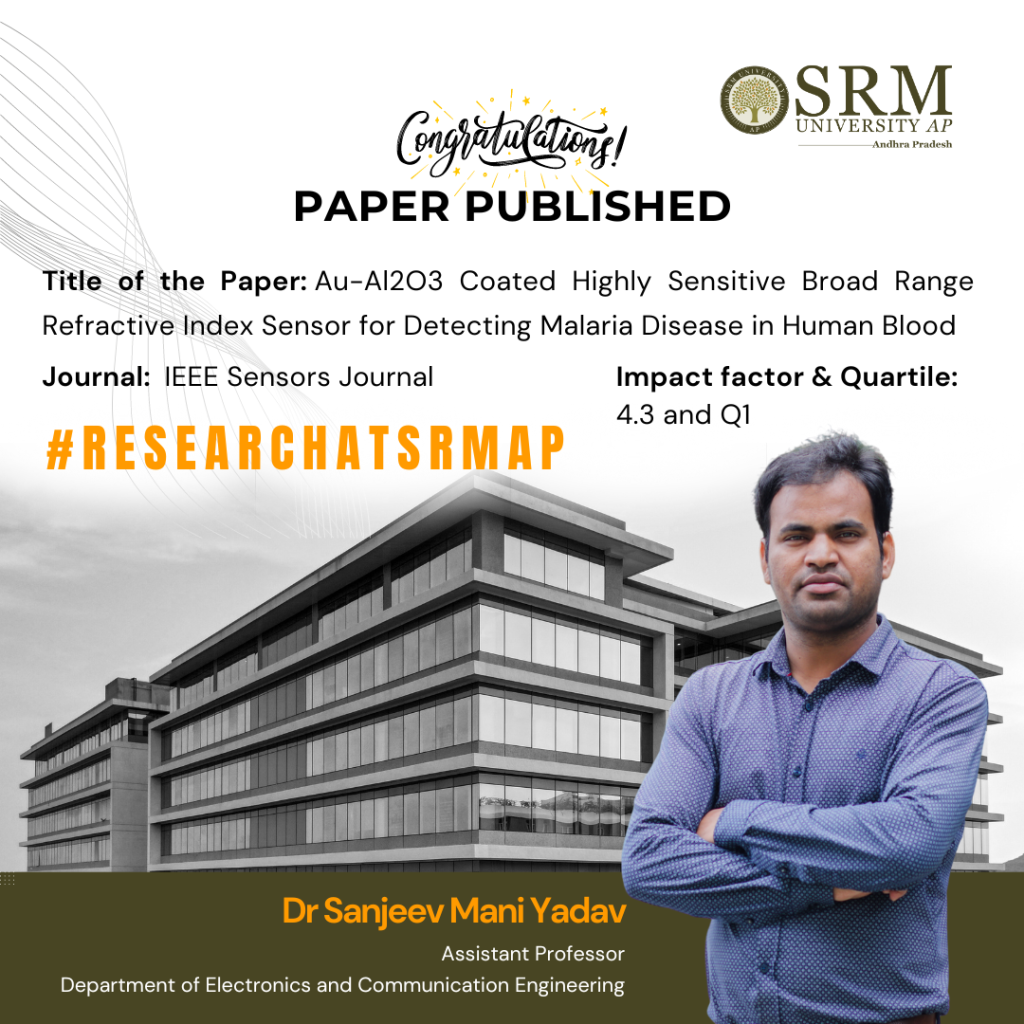
Dr Sanjeev Mani Yadav, Assistant Professor from the Department of Electronics and Communication Engineering, has published a cutting-edge research paper titled “Au-Al2O3 Coated Highly Sensitive Broad Range Refractive Index Sensor for Detecting Malaria Disease in Human Blood” in the IEEE Sensors Journal with an impact factor of 4.3. This research focuses on developing a highly sensitive biosensor using photonic crystal fibres and a technique called surface plasmon resonance (SPR) to detect changes in the refractive index, which is how much light bends when it enters a material. This biosensor can also detect malaria in the human body.
Abstract
The paper represents the photonic crystal fibre-based surface plasmon resonance (SPR) biosensor for broad-range refractive index sensors along with the detection of malaria disease in the human body. α-Al2O3-Au dielectric-metal interface has been proposed to stimulate the free electron on the metal surface via evanescent to result in an SPR phenomenon. The proposed sensor shows a sufficient shift in resonance wavelength for the change in external RI from 1.32 to 1.40 for an optimised Al2O3/Au thickness of 50nm/12nm. The broad-range sensing applicability of the designed sensor shows a maximum sensitivity of 6000 nm/RIU when the external RI changes from 1.38 to 1.40. The detection accuracy of the designed sensor is reported to be 1.66×10-5 (RIU) and reported compatible in comparison to broad RI sensors. The proposed SPR sensor has been utilised to sense the malaria diseases in the human body by filling infected RBC samples on the dielectric-metal surface. The proposed study aids in detecting various stages of malaria-infected RBCs, including the Ring phase, Trophozoite phase, and Schizont phase, by measuring the shift in resonance wavelength. The sensor’s wavelength sensitivity varies across the phases: 5714.28 nm/RIU for the Ring phase, 5263.15 nm/RIU for the Trophozoite phase, and 5931 nm/RIU for the Schizont phase. The sensor exhibits the highest reported sensitivity among other biological sensors in this category. The proposed sensor fulfils all the requirements for a diagnosis of early malaria disease in the human body, along with its high sensitivity, low detection limit, and capability of sensing broad RI.
How does the sensor work?
1. Biosensor Basics: The sensor uses a combination of a special crystal fibre and a metal surface (a mix of aluminium oxide and gold) to create a reaction when light hits it. This reaction is called SPR and it helps in detecting tiny changes.
2. Detecting Changes: When the external refractive index (a measure of how light bends in a substance) changes, the sensor detects this by a shift in the wavelength (colour) of the light. The study found that the sensor is very sensitive to changes in the refractive index between 1.32 and 1.40.
3. Sensitivity: The sensor is incredibly sensitive, with a maximum sensitivity of 6000 nm/RIU (nanometres per refractive index unit). This means it can detect very small changes very accurately.
4. Malaria Detection: The sensor can also detect malaria by analysing infected red blood cells. Different stages of malaria infection (Ring, Trophozoite, and Schizont) cause different shifts in the wavelength, which the sensor can measure. The sensor’s sensitivity varies slightly with each stage but is consistently high.
5. High Performance: This sensor is reported to have the highest sensitivity compared to other similar sensors and meets all the requirements for early malaria diagnosis due to its high sensitivity, low detection limit, and ability to detect a wide range of refractive indices.
In essence, this sensor is a powerful tool for detecting both refractive index changes and malaria in the human body with high accuracy and sensitivity.
Practical implementation/Social implications of the research
The photonic crystal fibre-based SPR biosensor represents a significant advancement in medical diagnostics with wide-ranging practical applications and social implications. Its high sensitivity and accuracy in detecting malaria and potentially other diseases can lead to better health outcomes, economic benefits, and improved access to healthcare, particularly in regions that need it the most.
Dr Sanjeev Mani Yadav acknowledges Dr Amritanshu Pandey, Electronics Engineering Department, IIT (BHU) Varanasi, for his continuous support and guidance throughout this research.
- Published in Departmental News, ECE NEWS, News, Research News
Cutting-Edge Research by Dr Chinnadurai Elevates MIMO Wireless Communication Standards
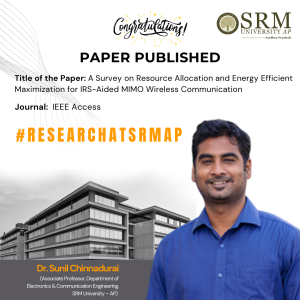
A Survey on Resource Allocation and Energy Efficient Maximization for IRS-Aided MIMO Wireless Communication
In a significant advancement for wireless communication technology, Dr Sunil Chinnadurai, Associate Professor in the Department of Electronics & Communication Engineering, has made a remarkable contribution to the field. His latest paper, titled “A Survey on Resource Allocation and Energy Efficient Maximization for IRS-Aided MIMO Wireless Communication,” has been published in the prestigious journal IEEE Access.
The paper delves into the intricacies of Intelligent Reflecting Surfaces (IRS) and their role in enhancing Multiple Input Multiple Output (MIMO) wireless communication systems. Dr. Chinnadurai’s research focuses on optimizing resource allocation and maximizing energy efficiency, which is a critical aspect of sustainable technological development.
This publication is expected to pave the way for more efficient and environmentally friendly wireless communication solutions, reflecting Dr Chinnadurai’s commitment to innovation and excellence in research.
Abstract of the Research
This paper surveys the integration of Multiple-Input Multiple-Output (MIMO) systems with Intelligent Reflecting Surfaces (IRS) in wireless communications. It explores how IRS technology enhances MIMO performance by manipulating the propagation environment through improved signal manipulation and beamforming. The survey covers resource allocation, energy efficiency techniques, optimization strategies, and practical implementation challenges. Key research areas and future directions are highlighted, emphasizing the potential of MIMO-enabled IRS systems to enhance wireless communication efficiency and coverage significantly.
Explanation of the Research in Layperson’s Terms
This paper explores how two advanced technologies, MIMO and IRS, can improve wireless communications. MIMO uses multiple antennas to enhance data transmission, while IRS involves smart surfaces that direct signal paths to boost strength and coverage. By combining these technologies, the paper examines how to make wireless networks faster, more reliable, and energy-efficient. It discusses practical ways to implement these improvements and identifies challenges and future research areas to make these advancements widely usable. In essence, this combination promises better wireless connectivity for everyone.
Practical Implementation or the Social Implications Associated with the Research
Integrating MIMO and IRS technologies into wireless networks can significantly enhance network performance, especially in urban and rural areas. Telecommunications companies can install IRS panels on structures to boost signal strength and coverage, while smart homes and cities can benefit from improved IoT connectivity and energy management. This combination also promotes energy-efficient networks, reducing operational costs and environmental impact. Socially, this technology can bridge the digital divide, providing better internet access to underserved areas and enhancing education, healthcare, and economic development. It supports new business models and innovations, leading to job creation and economic growth. Improved connectivity enhances quality of life through better access to information, entertainment, and remote work opportunities. Additionally, it strengthens public safety by improving communication during emergencies. Combining MIMO and IRS technologies promises a more connected, efficient, and sustainable world.
Pictures Related to the Research:
Future Research Plans
Future research on MIMO and IRS integration should focus on advanced optimisation for resource allocation and energy efficiency, innovative beamforming strategies, practical deployment challenges, and robust security protocols. Enhancing energy efficiency and contributing to standardization and regulation is also critical. These efforts will unlock the full potential of MIMO and IRS, leading to more efficient, reliable, and secure wireless communication systems.
- Published in Departmental News, ECE NEWS, News, Research News
Innovative System for Detection and Classification of Manufacturing Defects in PCB
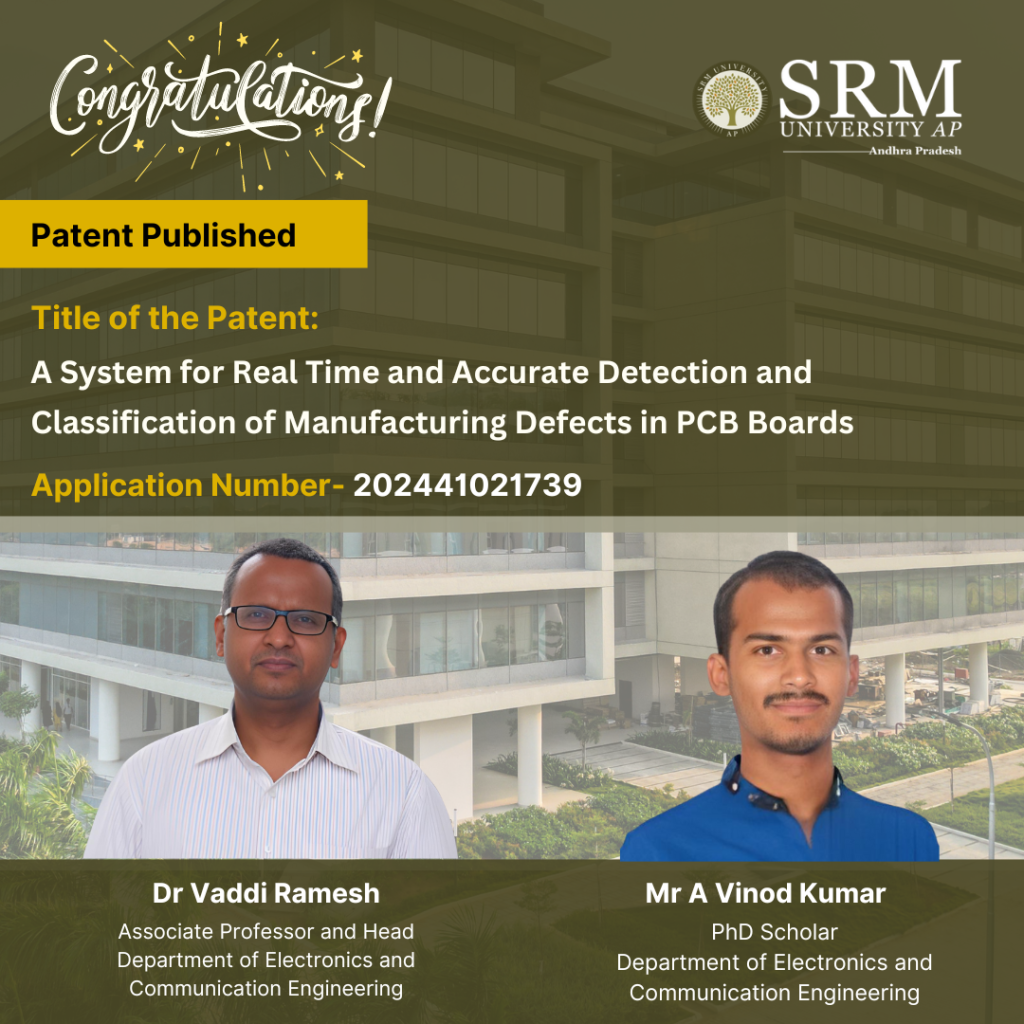
Dr Ramesh Vaddi, Associate Professor & Head of the Department of Electronics and Communication Engineering, along with his PhD Scholar Mr A Vinod Kumar has developed a new system for real-time and accurate detection and classification of manufacturing defects in Printed Circuit Boards (PCBs). This groundbreaking invention has been filed and published with Application Number: 202441021739 in the Patent Office Journal.
Abstract
This study presents a new system for real-time detection and classification of defects in Printed Circuit Boards (PCBs), which are critical in electronic products and systems. It employs an efficient model with pre-trained weights to detect defects for enhanced quality control. The model is initially trained and fine-tuned on a computer and then deployed on a compact computing board. For real-time imaging, a high-definition USB camera is connected to the system, allowing direct defect identification without the need for external devices. The output is shown on a monitor, with the PCB image featuring clearly labelled boxes to indicate the type and location of defects. This method offers a streamlined approach to defect classification, helping to improve the quality control process in electronics manufacturing.
Explanation of the Research in Layperson’s Terms
This research focuses on finding defects in PCBs, which are essential for most electronic devices like computers and phones. The system uses a powerful computer model to quickly identify any defects in real time. The model is trained on a regular computer to recognise normal PCBs and various defects. Once ready, it is transferred to a small, efficient computer board. A camera captures images of the PCBs, and the system analyses these images to identify defects. The results are displayed on a screen, clearly marking where the defects are and what types they are. This helps companies quickly and accurately detect defects in their electronics manufacturing process, saving time, reducing waste, and improving product quality
Practical Implementation/Social Implications of the Research
The practical implementation of this research involves deploying a system for real-time detection and classification of defects in PCBs, essential components in nearly all electronic devices. Using advanced deep learning techniques, the system can quickly identify manufacturing defects early in the production process. This leads to significant improvements in quality control, reduced waste, and lower production costs. By improving quality control in electronics manufacturing, the system helps reduce electronic waste, a significant environmental concern. Early detection of defects also decreases the chances of faulty electronic products reaching consumers, enhancing safety and reducing the need for product recalls. The system’s efficiency and accuracy could lead to more reliable electronics, fostering greater consumer trust in electronic products. This, in turn, encourages companies to invest in higher-quality manufacturing processes, ultimately leading to a more sustainable and responsible electronics industry.
Collaborations
To develop this system, the research team first trained a computer model to recognise defects in PCBs. The training involved feeding the model a large dataset of PCB images, some with defects and some without. The model learned to identify common defects by analysing these examples. Once trained, the model was implemented in a real-time setting and integrated with equipment to inspect PCBs during production. The system used a camera to capture images of each PCB and applied the trained model to analyse these images for defects. Running in real-time, the system could immediately detect issues and alert the manufacturing team, allowing them to correct problems on the spot. This approach improved product quality, reduced the chances of defective electronics reaching consumers, sped up the quality control process, and reduced waste, making the manufacturing process more efficient.
Future Research Plans
The research team has outlined several future plans to enhance and expand their defect detection system for PCBs:
- Model Optimization: Refining the machine learning model to improve accuracy and speed, experimenting with different architectures and training techniques to boost performance.
- Expanded Defect Library: Gathering a more extensive dataset of PCB defects to enable the model to identify a wider range of issues, making the system more versatile for various manufacturing environments.
- Real-World Testing: Testing the system in a broader range of manufacturing settings to ensure robustness and adaptability, understanding performance in diverse scenarios, and fine-tuning for optimal results.
- Integration with Manufacturing Systems: Aiming to integrate the system with other manufacturing processes and technologies for seamless communication between defect detection and other quality control systems, enhancing overall workflow.
- Automation and Robotics: Exploring the use of automation and robotics to streamline the defect detection process, potentially leading to a more automated manufacturing line with reduced human intervention and errors.
- Collaboration and Partnerships: Planning to collaborate with more industry partners and academic institutions to accelerate research and development, gaining valuable insights and resources to advance the system.
- Published in Departmental News, ECE NEWS, News, Research News
Innovative Insights: Rupesh Kumar’s Book Unveils Advances in Wireless Technologies
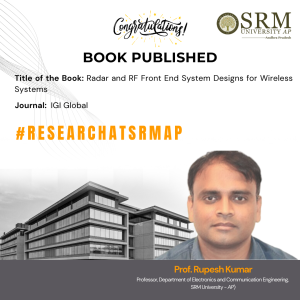 In a remarkable stride for the field of wireless communication, Prof. Rupesh Kumar from the Department of Electronics and Communication Engineering has authored a pivotal book that promises to redefine our understanding of radar and RF systems. The book, entitled “Radar and RF Front End System Designs for Wireless Systems,” is the latest gem in the prestigious “Advances in Wireless Technologies and Telecommunication (AWTT)” series.
In a remarkable stride for the field of wireless communication, Prof. Rupesh Kumar from the Department of Electronics and Communication Engineering has authored a pivotal book that promises to redefine our understanding of radar and RF systems. The book, entitled “Radar and RF Front End System Designs for Wireless Systems,” is the latest gem in the prestigious “Advances in Wireless Technologies and Telecommunication (AWTT)” series.
With his profound expertise, Prof. Kumar navigates through the complexities of designing state-of-the-art front-end systems, offering readers a treasure trove of knowledge that bridges theory and practical application. This book is set to become an essential read for aspiring engineers and seasoned professionals alike, enriching the academic and industry landscape with its innovative approach.
Join us in celebrating Prof. Kumar’s exceptional contribution to the world of electronics and communication engineering. Dive into the depths of this masterful work and emerge with insights that could shape the future of wireless systems.
About the Book:
Radar and RF Front End System Designs for Wireless Systems delves into the intricate world of wireless technologies, particularly focusing on radar and RF front-end systems. The advent of wireless communication has ushered in a new era of connectivity, revolutionising various sectors including healthcare, smart IoT systems, and sensing applications. In this context, the role of RF front-end systems, with their reconfigurable capabilities, has become increasingly vital. The impetus behind this book stems from the remarkable surge in innovation witnessed in RF front-end systems. Researchers and practitioners alike have contributed a plethora of new configurations and design architectures, paving the way for unprecedented advancements in wireless systems. Our aim with this publication is to provide a platform for researchers to explore both theoretical insights and practical applications, thereby facilitating the dissemination of the latest trends and developments in the field. The contents of this book cover a wide spectrum of topics, ranging from RF frontend antenna systems to the impact of artificial intelligence and machine learning in system design. With contributions from experts in academia and industry, readers can expect a comprehensive exploration of radar and antenna system design, modeling, and measurement techniques. We envision this book serving as a valuable resource for students, researchers, scientists, and industry professionals seeking to deepen their understanding of RF front-end antenna and radar system designs. Whether it’s exploring reconfigurable antenna systems for 5G/6G networks, or delving into radar modelling and signal processing techniques, this book offers insights that are both timely and relevant.
Co-author of the Book:
Shilpa Mehta, a co-author of the book, holds a PhD from Auckland University of Technology, New Zealand. Presently, she serves as a Teaching Assistant at AUT, Auckland. Shilpa received the Summer Doctoral Research Scholarship for her PhD work. Her research spans across projects such as Radio Frequency Integrated Circuits, RF front ends, Optimization, Internet of Things, Wireless Communication, Artificial Intelligence, Healthcare, Radars, Software-defined Radios, and Smart Cities.
For the Book Chapter Publication, Click the Link
- Published in Departmental News, ECE NEWS, News, Research News
Innovative Wind Turbine System Patent Awarded to Dr Goutam Rana and Team
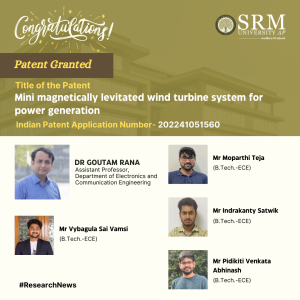 In a significant advancement for sustainable energy technology, the Indian Patent Office Journal has officially granted a patent for the “Mini magnetically levitated wind turbine system for power generation.” This groundbreaking invention, bearing Application Number: 202241051560, is the brainchild of Dr Goutam Rana, Assistant Professor in the Department of Electronics and Communication Engineering.
In a significant advancement for sustainable energy technology, the Indian Patent Office Journal has officially granted a patent for the “Mini magnetically levitated wind turbine system for power generation.” This groundbreaking invention, bearing Application Number: 202241051560, is the brainchild of Dr Goutam Rana, Assistant Professor in the Department of Electronics and Communication Engineering.
Dr Rana, along with his dedicated team of B. Tech ECE students—Mr Vybagula Sai Vamsi, Mr Moparthi Teja, Mr Indrakanty Satwik, and Mr Pidikiti Venkata Abhinash have developed a system that promises to revolutionise how we harness wind energy. The turbine’s miniaturised and magnetically levitated design allows for efficient power generation with minimal mechanical friction, leading to a longer lifespan and reduced maintenance costs.
The team’s innovation aligns with global efforts to transition to renewable energy sources and showcases the potential of academic research in contributing to real-world challenges. The patent grant not only recognises the technical ingenuity of the invention but also underscores the collaborative spirit of the students and faculty at the institution.
Abstract:
Due to the increasing demand and supply gap, in the electrical energy system, wind energy is coming out as an alternative form of clean-with zero-carbon footprint renewable energy sources for power generation. The same is true for hydrocarbon-based fuels whose resources are limited and the contribution of vehicular pollution is also raising concerns in every-degrading the air quality index (AQI) of Indian cities. The electric and hybrid vehicles thus emerging fast as an alternative but often being hindered by the unavailability of proper charging infrastructures on roads.
The current invention is aimed to enable the use of wind turbines for harnessing wind energy and utilize the same to charge batteries of electrical vehicles or hybrid vehicles. The major challenges that have prevented the use so far are mainly two viz. low air flow and larger air drag. To address low airflow in normal road conditions in congested city alleys, we demonstrated the use of magnetically levitated Vertical-axis turbines instead of conventional ball-baring-based Horizontal-axis wind turbines. To reduce the air drag the use of vertical axis magnetically levitated wind turbines is a good option since the air drag experienced in the blade unit is not exactly in contact with the car body.
To improve on the drag further we have introduced an array of mini turbine units instead of one big unit which helps in distributing the total drag over a large area and since air can pass easily through small units overall drag experienced will be small. Also, to keep the levitation small, the rotating unit is made lighter with 3D printing perforated PLA material.
The rest of the operation of the system is similar to any wind turbine system i.e. with the help of permanent magnet and coil arrangement we will convert the wind energy (rotor movement) into electrical energy (e.m.f.). Only here instead of one single source, we will generate multiple small sources of induced electrical energy which can then be coupled together and used for charging the battery.
Since the invention uses magnetic levitation, friction is minimal. This helps the rotor to become independent of natural wind flow and use the movement of the vehicle to generate the required torque for the rotor movement. Our invention can be installed in the rooftop space of any vehicle and since it is divided into an array of smaller units, allows the optimum use of available space of the used vehicle. Overall cost and weight are also very minimal. Here, the most practical use case can be the widespread E-rickshaws in India. The choice of the use case is based on the fact of their large presence, longer run hours, and limited speed for the runs.
Explanation of the Invention in Layperson’s Terms:
The invention will act as a source of energy and can be used to charge batteries of electric vehicles or hybrid vehicles. The device converts wind energy to electrical energy through mini wind turbine arrays which can be placed on top of the rooftop of the vehicles. The rotor is kept suspended from the stator unit using magnets to eliminate friction. This helps to operate the device without the presence of strong natural wind, it utilizes the movement of the vehicle to generate the necessary rotation. The mini turbine arrays and magnetic suspension help to reduce the effect of wind drag (extra wind replaced by the turbine unit).
Practical Implementation or the Social Implications Associated
The invention is intended to solve a few on-road challenges of Electric Vehicles (EVs). The current invention is:
1. Low cost and one-time investment with zero maintenance charge for an EV
2. The proposed device can act as a secondary power source for the vehicle
3. The proposed device will convert wind energy, thus completely environment-friendly, and with comes with absolutely zero carbon footprint
4. The proposed device can add some extra mileage to the current battery storage as much as it runs.
5. With other renewable sources together a hybrid vehicle can be built which is free of fossil fuel completely.
Future Research Plans:
The current invention is in just proof of concept stage. We are currently working on the following
1. to improve the overall efficacy of the device such that each unit can harness wind energy to its optimal potential. With this, we will try to ensure that the battery gets charged completely (or at least a significant percentage) during each run during the day.
2. We are also working on the numerical study to calculate the actual wind drag with a more optimal design so that we can estimate how many units a certain vehicle will require and what should be the optimal placement scheme to utilize the maximum wind effect.
- Published in Departmental News, ECE NEWS, News, Research News
Groundbreaking Research on Optimal Routing Protocol in IEEE Sensors Journal
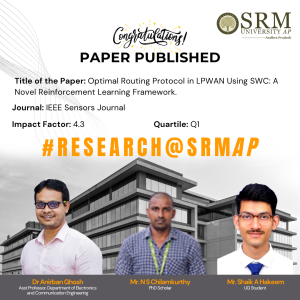 In a significant academic achievement, Dr Anirban Ghosh, Assistant Professor from the Department of Electronics and Communication Engineering along with Mr Naga Srinivasarao Chilamkurthy, PhD Scholar, and Mr Shaik Abdul Hakeem, an undergraduate student, have made a remarkable contribution to the field of communication engineering. Their paper, titled “Optimal Routing Protocol in LPWAN Using SWC: A Novel Reinforcement Learning Framework,” has been published in the esteemed IEEE Sensors Journal, with an impressive impact factor of 4.3.
In a significant academic achievement, Dr Anirban Ghosh, Assistant Professor from the Department of Electronics and Communication Engineering along with Mr Naga Srinivasarao Chilamkurthy, PhD Scholar, and Mr Shaik Abdul Hakeem, an undergraduate student, have made a remarkable contribution to the field of communication engineering. Their paper, titled “Optimal Routing Protocol in LPWAN Using SWC: A Novel Reinforcement Learning Framework,” has been published in the esteemed IEEE Sensors Journal, with an impressive impact factor of 4.3.
This publication marks a milestone for the university and highlights the innovative research being conducted by its faculty and students. The paper delves into the development of an optimal routing protocol for Low-Power Wide-Area Network (LPWAN) using State-Wise Communication (SWC), employing a novel reinforcement learning framework to enhance network efficiency and performance.
This work will pave the way for advancements in LPWAN technologies, which are crucial for the Internet of Things (IoT) ecosystem. The university community celebrates this achievement and looks forward to the positive impact it will have on technology and society.
Abstract:
Low Power Wide Area Network (LPWAN) has emerged as a dominating communication technology that offers low-power and wide coverage for the Internet of Things (IoT) applications. However, the direct data transmission approach has a limited network lifetime. Even multi-hop data transmission experiences several difficulties including high data latency, poor bandwidth utilization, and reduced data throughput. To overcome these challenges, in this paper, a recent breakthrough in social networks known as Small-World Characteristics (SWC) is incorporated into LPWANs.
In particular, in this work, Small-World LPWANs (SW-LPWANs) are developed by using the Reinforcement Learning (RL) technique and using different node centrality measures like degree, betweenness, and closeness centrality. Further, the performance of the developed SW-LPWANs is evaluated in terms of energy efficiency (alive/dead devices, and network residual energy) and Quality-of-Service (average data latency, data throughput, and bandwidth utilization), and is compared with that of conventional multi-hop LPWAN. Finally, to validate the simulation results, similar analyses are performed on the real-field LPWAN testbed.
The obtained simulation results confirm that SW-LPWAN developed by the RL method performs better than other techniques, with 11% more alive devices, 5.5% higher residual energy, 2.4% improved data throughput, and 14% efficient bandwidth utilization compared to the next best method. A similar trend is observed with real-field LPWAN testbed data also.
Explanation of the Research in Layperson’s Terms
Social networks primarily revolve around establishing human connections, whereas LPWANs are designed for connecting IoT devices that have limited battery-driven power. In this context, the smart devices must communicate in an IoT setting to conserve the limited energy available to them. To achieve this, the concept at the core of social networking also known as small world characteristic is incorporated into LPWAN using the Q-learning technique.
Practical Implementation or the Social Implications of the Research
IoT applications such as remote healthcare, smart environmental monitoring, asset tracking, and smart traffic systems require low transmission delay and high network lifetime. The proposed research helps in achieving the above parameters.
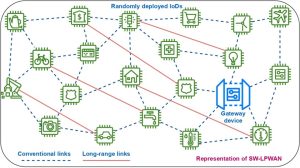
Collaborations
Dr Om Jee Pandey, Assistant professor Department of Electronics Engineering, Indian Institute of Technology, (BHU), Varanasi. e-mail: omjee.ece@iitbhu.ac.in
Dr Linga Reddy Cenkeramaddi, Professor, Department of Information and Communication Technology, University of Agder, Norway. e-mail:linga.cenkeramaddi@uia.no
Future Research Plan
In the next phase of research, we will be interested in investigating how the energy efficiency and other quality of service of smart devices in an IoT setting can be improved if they are partially or completely mobile.
- Published in Departmental News, ECE NEWS, News, Research News
Groundbreaking Research on Advanced Technology Nodes
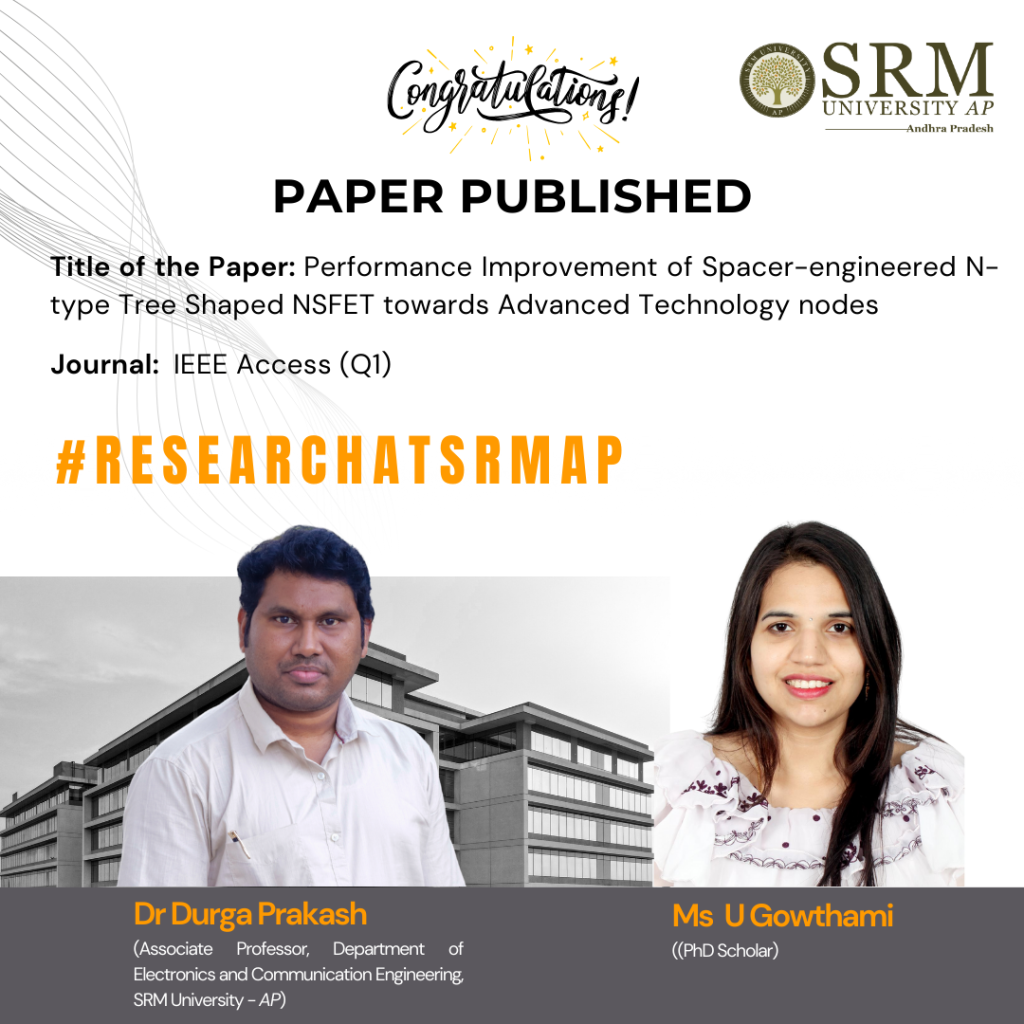
Dr M Durga Prakash, Assistant Professor in the Department of Electronics and Communication Engineering, and his PhD scholar, Ms U Gowthami, have published a research paper titled “Performance Improvement of Spacer-engineered N-type Tree Shaped NSFET towards Advanced Technology nodes” in the Q1 journal, IEEE Access. The paper has an impact factor of 3.9 and will pave the way for significant advancements in the field.
Here’s an abstract of their research paper
Abstract:
Scaling gate lengths deep is most reliable with tree-shaped Nanosheet FETS (NSFET). This paper uses TCAD simulations to study the 12nm gate length (LG) n-type Tree-shaped NSFET with a stack of high-k dielectric (HfO2) and (SiO2) spacers. The Tree-shaped NFET device features high on-current (ION) and low off-current (IOFF) with T(NS) = 5 nm, W(NS) = 25 nm, WIB=5nm, and HIB = 25 nm. Comparison of single- and dual-k spacer 3D devices and DC properties are shown. Because fringing fields with spacer dielectric prolong the effective gate length, the dual-k device has the highest ION / IOFF ratio, 109, compared to 107. This research also examines where work function, inter bridge height, breadth, gate lengths, temperature, and analog/RF and DC metrics affect the device. The suggested device has good electrical properties at 12 nm LG, with DIBL = 23 mV/V, SS = 62 mV/dec, and switching ratio (ION / IOFF) = 109. The device’s performance proves Moore’s law applies to lower technological nodes, enabling scalability.
The link to the article- https://ieeexplore.ieee.org/document/10499264 DOI: 10.1109/ACCESS.2024.3388504

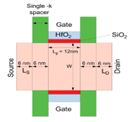
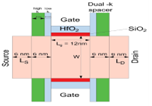
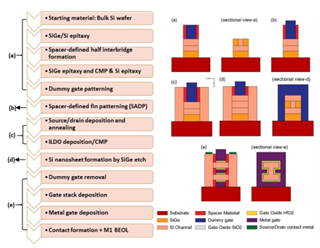
- Published in Departmental News, ECE NEWS, News, Research News


